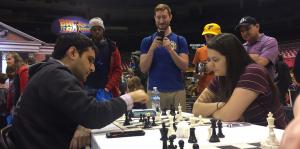Giri-Morozevich 2012, Rubinstein-Lasker 1909 | Games to Know by Heart - GM Elshan Moradiabadi
Grandmaster Elshan Moradiabadi shows two classic games with themes of attacking an uncastled king and attacking a castled king, respectively.
Grandmaster Elshan Moradiabadi shows two classic games with themes of attacking an uncastled king and attacking a castled king, respectively.
Grandmaster Elshan Moradiabadi reviews a viewer submission from an Australian player, William Wedding (URS: 1960). He managed to draw GM Nigel Short in a simul.
2017.04.06
Nigel Short vs. William Wedding: C57 two knights defence, Fritz variation
Grandmaster Elshan Moradiabadi presents several endgame studies, proving that endgames are anything but boring. Calculate and find the best possible moves.
2017.03.28
by Richard Pointer, Scholastic Coordinator
This past Sunday, scholastic chess returned to Saint Louis University with the 2017 Spring Fever Tournament. As word has spread about our tournaments, new players and teams have continued to sign up and compete. With such wonderful weather and a great location, the tournament was able to draw 135 students to participate in both the K-6 and K-12 sections.

One of the best things about chess is that it applies to everyday life. In my humble opinion, chess is a sport for a variety of reasons , however, I too find great advantage for chess in the community. The game I love has great appeal to artists and art enthusiasts and has made its way into pop culture. For instance, World Champion Magnus Carlsen has made it to the Simpsons as a character representing him.

| Place | K-6 Standings | K-12 Standings |
|---|---|---|
| 1 | Oak Brook Elementary | Parkway Southwest Middle |
| 2 | Glenridge Elementary | Hazelwood West High School |
| 3 |

Ben Simon covers the best of the weekend of this international tournament. Twenty-six players from eleven nations compete in two ten-player round robins and one six-player double round robin with a combined $50,000 prize fund. Hear from GMs Dariusz Swiercz and Akshat Chandra.
USChessChamps.com
Ben Simon covers the best of the fourth day of this international tournament. Twenty-six players from eleven nations compete in two ten-player round robins and one six-player double round robin with a combined $50,000 prize fund. Hear from GM Sandro Mareco and IM Cemil Can Ali Marandi.
USChessChamps.com
These words become increasingly clear every time I step into the classroom, but never from the same perspective. When I first started teaching, my own understanding of the core mathematics content grew in part because I had to readily explain the material to many different kinds of learners and learning styles.